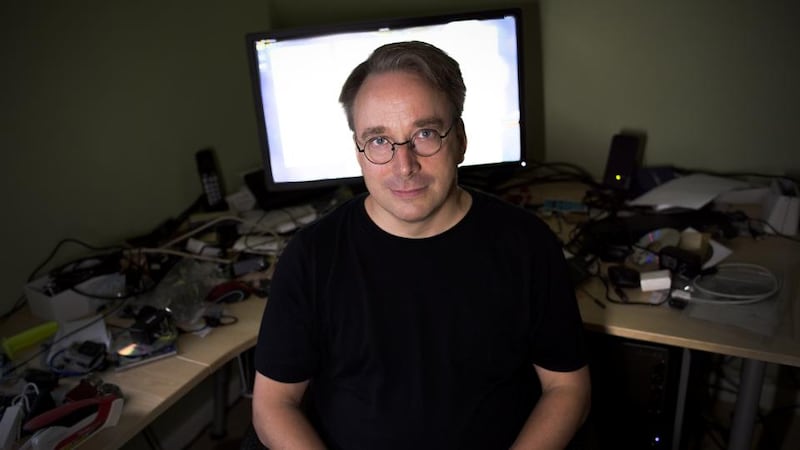Chances are, your personal laptop or desktop PC is running either Windows or the Mac operating system, MacOS. Estimates vary, but Windows makes up between 60-70 per cent of the desktop market, and MacOS, about 15-20 per cent (according to Statcounter and Statista).
In third place comes Linux, hovering just below 3 per cent (excluding Chrome and Android, both built on the Linux “kernel”).
On the other hand, Linux utterly dominates the enterprise market, “with a staggering 97 per cent” of some aspects of that market in 2022, and seeing robust growth, according to analysts Skyquest.
Much of what you do online or in the cloud happens in the Linux environment. Linux runs 96 per cent of the top million websites. It’s amazing for a freely available, open-source operating system created by one man and modified over time by innumerable programmers.
READ MORE
It wasn’t always that way. In 1998, I sat in an auditorium in Silicon Valley and watched a panel that included Linux inventor Linus Torvalds and representatives from Intel and Netscape. Those two tech giants of the time had just announced they’d taken a stake in then-tiny Linux company, Red Hat.

This was a dramatic step, as Linux was (and still is) a rebel OS. Even though lots of sysadmins secretly ran Linux down in corporate and government server rooms back then, it was often done surreptitiously because, as I noted, board rooms don’t like the idea of not having a company to sue if things go wrong.
That single investment in Linux mainstreamed it. These days, Linux is big business for companies like Oracle and IBM. On the desktop, it leads a different life. It’s especially beloved of tech types who like its price point of “free”, its versatility and openness and the fact that they can tinker away with it – “it” being whichever of the over 600 distributions they might use.
But that flexibility can make it daunting for the average computer user. Though some manufacturers offer Linux as an option, usually you’ll have to install it yourself, perhaps on to an older computer, or on to a disk partition – a segment isolated on your hard disk – of your current machine.
It’s been 20 years since I installed Red Hat on an old laptop. So when I saw a recent post on Mastodon flagging a “Linux install fest” hosted by group of enthusiasts, the Dublin Linux Community, I brought along a five-year-old Microsoft surface laptop to experiment.
Linux allows you to keep using your hardware
— Conor Murphy
I was welcomed into a room off the Dublin quays by Conor Murphy, the community’s manager and co-host of the Linux Lads podcast, who demonstrated a range of Linux distributions running on a variety of old and new laptops and tablets.
Linux can breathe new life into machines too old to get Windows or Mac OS updates, he says, pointing out a worn Asus netbook, a machine of Windows XP vintage, running Linux distribution Debian.
“Linux allows you to keep using your hardware,” he says, adding that Linux is “completely free, free as in cost but also philosophy”. I’ve always had a bit of a grá for that core sense of community and dedication to keeping computer code open and freely available to all that is central to Linux and the wider FOSS (free and open source software) movement.
Windows machines are more amenable to Linux than Macs, simply because MacOS is “locked down” more, Murphy says, though older Macs running on Intel chips are good candidates too.
Around me, people sit and stand in small groups, drinking free coffee, engrossed in Linux-y discussions or gathered around someone attempting an installation. I decide I’ll opt for Zorin, a Linux version using the popular Ubuntu distribution, from a Dublin-based company (“Irish Linux!” says Murphy). It looks and feels similar to Windows 10 or 11.
I’m handed off to a friendly, chatty group member (and fellow-Californian) Dave, who sits me down and, voila, does the installation himself for me in about 10 minutes, explaining the process as we go along. The trickiest bit is correctly creating and formatting the disk partition, but this works on the second try.
[ Worried about your online privacy? A good VPN is your best betOpens in new window ]
Zorin has a nice, neat user interface and I can click into a software “store” that has lots of free downloads to do just about anything you’d do on a Windows or Mac machine – word processing, photo editing, music production, social media.
There’s a learning curve to all of this that many won’t want, but others will relish. I don’t think Linux is likely to become my main desktop OS but I’m delighted to have it back on a laptop and I’m ready to explore what’s changed in two decades, from writing to gaming to photo management.
For others wanting a friendly introduction to Linux, check the group’s website. It holds install fests a few times a year and meets twice monthly, alternating online and in person. And if you’re a Linux newbie, you’ll find no shortage of enthusiasm and support to get you up and running.
- Sign up for Business push alerts and have the best news, analysis and comment delivered directly to your phone
- Find The Irish Times on WhatsApp and stay up to date
- Our Inside Business podcast is published weekly – Find the latest episode here


















